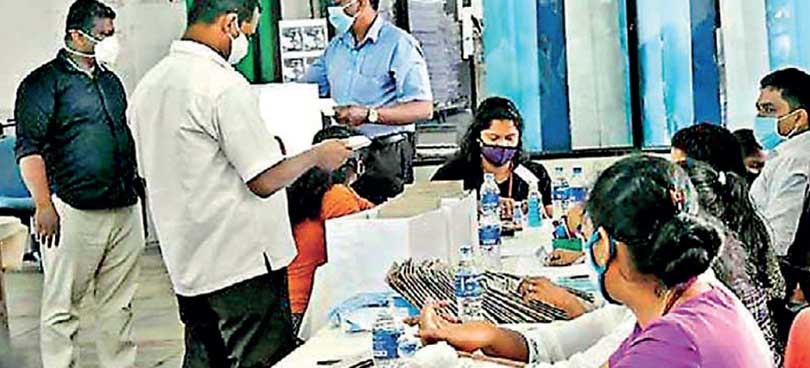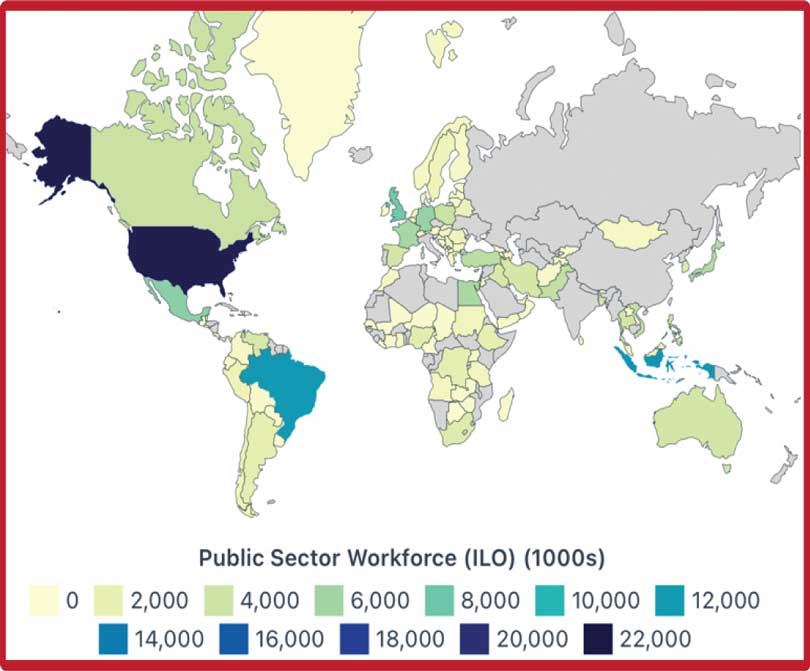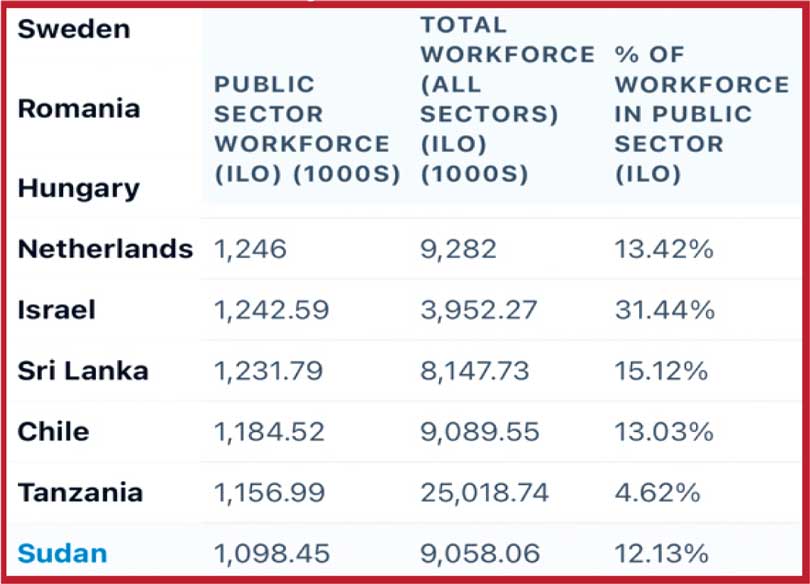Friday Apr 04, 2025
Friday Apr 04, 2025
Tuesday, 31 December 2024 00:02 - - {{hitsCtrl.values.hits}}

Smart sizing offers Sri Lanka a strategic pathway to modernising its public sector


 The public service is a major employer in Sri Lanka, engaging approximately 1.3 million people. Recently, Presidential Advisor Duminda Hulangamuwa remarked that the country would need to downsize its State sector employee pool from its existing 1.3 million to 750,000. Sri Lanka’s public sector has historically served as a cornerstone of governance and public service delivery. However, persistent challenges such as inefficiency, overspending, and a lack of accountability have significantly hindered its performance.
The public service is a major employer in Sri Lanka, engaging approximately 1.3 million people. Recently, Presidential Advisor Duminda Hulangamuwa remarked that the country would need to downsize its State sector employee pool from its existing 1.3 million to 750,000. Sri Lanka’s public sector has historically served as a cornerstone of governance and public service delivery. However, persistent challenges such as inefficiency, overspending, and a lack of accountability have significantly hindered its performance.
Data from the International Labour Organisation (ILO) reveals that Sri Lanka’s public sector employs approximately 1.23 million people, representing 15.12% of the country’s total workforce (ILO, 2024). This proportion highlights the significant role of the public sector in national employment. The ILO’s insights, coupled with a global map showcasing the size of public sector workforces, underscore the varying levels of government involvement in economies. Additionally, comparative data highlights Sri Lanka’s unique challenges in balancing workforce size with efficiency. Addressing these challenges through “smart sizing” offers a strategic pathway towards efficiency and sustainability.
What is smart sizing?
Smart sizing is a strategic approach aimed at optimising the size and structure of the public sector. Unlike conventional downsizing, which focuses primarily on workforce reduction, smart sizing emphasises aligning resources with governmental goals to enhance efficiency and effectiveness. This approach ensures adequate staffing to meet public service requirements while minimising redundancies and waste.
Challenges facing Sri Lanka’s public sector
The Sri Lankan public sector faces several systemic issues that underscore the need for reform. Since 2005, public sector employment has increased by approximately 60%, consuming 26% of public expenditure (Institute of Policy Studies, 2024). Despite this growth, the Government’s effectiveness is rated poorly, with a score of -0.65 on global governance indices. Outdated processes, overlapping roles, and bureaucratic red tape further hinder productivity and responsiveness. Additionally, the public sector lags in adopting modern technologies, leaving it ill-equipped to meet the demands of a rapidly evolving global economy. These challenges highlight the urgent need for comprehensive reforms to improve efficiency, governance, and service delivery.
Key steps in smart sizing
Implementing smart sizing involves several critical steps. The process begins with a detailed evaluation of each department’s roles, workload, and performance metrics.
This evaluation is crucial for identifying inefficiencies and ensuring that resources are allocated optimally. Productivity measurement frameworks, such as the input-output method proposed by the National School of Business Management (NSBM), enable targeted reforms. These frameworks ensure that essential departments remain well-supported while underperforming areas are streamlined (NSBM, 2021).
Technology integration is another important step. The adoption of automation, artificial intelligence, and data analytics can significantly reduce reliance on manual processes, enhancing service delivery. Initiatives such as the Lanka Government Network 2.0 play a pivotal role in digitising public sector operations (Sri Lanka Telecom, 2019). Reskilling and upskilling the workforce also form a key component of smart sizing. Rather than resorting to job cuts, addressing skill gaps ensures that employees remain adaptable to new challenges while preserving institutional knowledge.
Governance reforms are integral to smart sizing. Strengthening governance frameworks with a focus on transparency, accountability, and performance metrics can drive departmental efficiency. Regular audits and results-based management further enhance this process (FT, 2024). Public-private collaboration is another avenue for improvement. Partnerships with private entities on non-core activities, infrastructure development, and service delivery can help improve outcomes while reducing inefficiencies.
Contd. on Page 13
(The writer is a Lecturer in Accounting, Finance, and Business at a UK university.)
Benefits of smart sizing
Adopting smart sizing can lead to significant benefits for Sri Lanka. Improved service delivery is one of the most notable outcomes, as a leaner, more efficient public sector can respond to citizen needs more effectively. Optimised processes and workforce adjustments contribute to cost savings, which in turn lead to better fiscal management. Greater transparency and accountability can rebuild public trust in government institutions. A streamlined public sector also fosters a favourable business environment, encouraging private-sector investments. Finally, initiatives like the Citra Social Innovation Lab, which integrates design thinking into government processes, promote adaptability and innovation in service delivery (UNDP, 2023).
Conclusion
Many public servants prefer the security of overmanned workplaces over the rigorous demands of achieving set goals. Smart sizing offers Sri Lanka a strategic pathway to modernising its public sector. By focusing on optimisation rather than reduction, this approach ensures efficiency, cost savings, and enhanced service delivery while fostering innovation and governance. Implementing smart sizing gradually and scientifically will not only reduce the burden on taxpayers but also strengthen public trust and contribute to the country’s long-term economic sustainability.
References:
nFT (2024) ‘Evaluating Performance in the Public Sector.’ Financial Times. Available at: https://www.ft.lk/columns/Evaluating-performance-in-the-public-sector/4-755408 (Accessed: 10 December 2024).
nInstitute of Policy Studies (IPS) (2024) ‘A Low Productivity Trap: Strengthening Skills, Jobs, and Public Sector Efficiency in Sri Lanka.’ Institute of Policy Studies. Available at: https://www.ips.lk/talkingecon
omics/2024/10/15/a-low-productivity-trap-strengthening-skills-jobs-and-public-sector-efficiency-in-sri-lanka (Accessed: 10 December 2024).
nInternational Labour Organisation (ILO) (n.d.) ‘Building High-Quality Public Service in Sri Lanka Through Workplace Reform.’ Available at: https://www.ilo.org/publications/building-high-quality-public-service-sri-lanka-through-workplace-reform (Accessed: 10 December 2024).
nNational School of Business Management (NSBM) (2021) ‘Developing a Framework for Productivity Measurement in Sri Lankan Public Sector: Insights from Literature.’ NSBM. Available at: https://www.nsbm.ac.lk/wp-content/uploads/2021/08/ICOBI_2020_Developing-a-Framework-for-Productivity-Measurement-in-Sri-Lankan-Public-Sector-Insights-from-Literature.pdf (Accessed: 10 December 2024).
nSri Lanka Telecom (SLT) (2019) ‘A Roadmap to Smart Sri Lanka.’ Sri Lanka Telecom. Available at: https://www.slt.lk/reports-html/annual/2019/a_roadmap_to_smart_sri_lanka/a_roadmap_to_smart_sri_lanka.html(Accessed: 10 December 2024).
nUNDP (2023) ‘Citra: Bringing Innovation to Public Sector Service Delivery in Sri Lanka.’ United Nations Development Programme. Available at: https://www.undp.org/asia-pacific/stories/citra-bringing-innovation-public-sector-service-delivery-sri-lanka (Accessed: 10 December 2024).
Discover Kapruka, the leading online shopping platform in Sri Lanka, where you can conveniently send Gifts and Flowers to your loved ones for any event including Valentine ’s Day. Explore a wide range of popular Shopping Categories on Kapruka, including Toys, Groceries, Electronics, Birthday Cakes, Fruits, Chocolates, Flower Bouquets, Clothing, Watches, Lingerie, Gift Sets and Jewellery. Also if you’re interested in selling with Kapruka, Partner Central by Kapruka is the best solution to start with. Moreover, through Kapruka Global Shop, you can also enjoy the convenience of purchasing products from renowned platforms like Amazon and eBay and have them delivered to Sri Lanka.
Discover Kapruka, the leading online shopping platform in Sri Lanka, where you can conveniently send Gifts and Flowers to your loved ones for any event including Valentine ’s Day. Explore a wide range of popular Shopping Categories on Kapruka, including Toys, Groceries, Electronics, Birthday Cakes, Fruits, Chocolates, Flower Bouquets, Clothing, Watches, Lingerie, Gift Sets and Jewellery. Also if you’re interested in selling with Kapruka, Partner Central by Kapruka is the best solution to start with. Moreover, through Kapruka Global Shop, you can also enjoy the convenience of purchasing products from renowned platforms like Amazon and eBay and have them delivered to Sri Lanka.